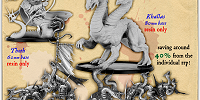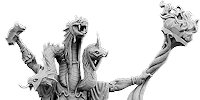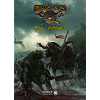|
How to Prepare Resin Miniatures
|
|
Here at Mierce Miniatures we're committed to creating the finest quality miniatures in wargaming, which is why we manufacture them in polyurethane resin for this material does not shrink under pressure (as metal does) and nor is it bereft of detail as many conventional hard plastic miniatures are. Even so, resin can be a little tricky to work with at first, especially if you are used to handling metal or plastic miniatures, and so we've produced a short guide in how best to prepare your resin miniatures for painting. If you follow these instructions your paintjob has the best possible start!
|
|
Firstly, please be aware that resin dust is unpleasant and potentially harmful so before drilling, sanding or cutting resin please ensure you are wearing an appropriate dust mask. Additionally, when cutting any resin miniature safety goggles should be worn as chips will undoubtedly fly off!
|
|
Any blades or other tools used to prepare resin miniatures should be sharp. It is very easy for a blunt tool to slip when cutting or scraping so a blunt blade is a lot more dangerous to you than a sharp one!
Resin is lightweight but tougher than you may think, but it can be brittle when clipped. Be careful when using clippers as some pieces may shatter in places you don't want them to. We advise you to cut or saw important pieces rather than using clippers.
Our miniatures are made from high quality polyurethane resin by experienced resin casters but during the casting process mould and flash lines may appear on your miniature. These are perfectly normal and can be removed easily by scraping them off with the edge of a sharp hobby knife or using a very fine wet and dry sandpaper to finish off any smooth areas.
|
|
It is very common for long and thin resin components such as banner poles or weapon hafts to bend after casting. This is nothing to worry about! If one of your components arrives like this, simply boil a kettle and place a little bit of the resulting hot water into a bowl. Then dip the bent section of the component into the hot water for about four seconds, being careful not to scald yourself of course!
Once you've taken the component out of the hot water bend it to your preferred shape and hold it like so for ten seconds - it will immediately set in that position. If it's still not quite right or you've messed it up, just do it again.
Be careful not to do it too much though - constantly bending resin will eventually cause it to become brittle and to snap.
|
|
To assemble your miniature we recommend pinning the individual pieces together using a hobby drill and metal rods such as paper clips. Bear in mind, however, that resin is denser than you may think and - again - you must wear safety goggles and a respirator mask. A good quality superglue is essential and we recommend using a superglue activator to give instant bonds. Be careful not to get any superglue on your fingers, however - activating superglue on your skin is rather painful!
|
|
Part of the resin casting process involves using a vacuum chamber to remove any air bubbles from the miniature. Occasionally a small air bubble may be present and these and any other areas (such as the join between two separate components) are easily filled using Milliput, Kneadatite (green stuff) or any other epoxy filler that floats your boat!
|
|
Before priming your miniature you should wash it in warm, soapy water and scrub it with an old toothbrush. This ensures the model is nice and clean and any release agents (used to stop the pieces sticking to the mould) that may stop the primer from binding are removed. Obviously delicate pieces need to be scrubbed carefully!
To get your miniature ready for a cracking paint job a good quality solvent-based aerosol primer should be used, which grips to resin much better than acrylic. A good primer is essential for a resin miniature so always prime first!
|
| |
|
join in with the discussion! |
|
|
|
 |
|
|
|



















